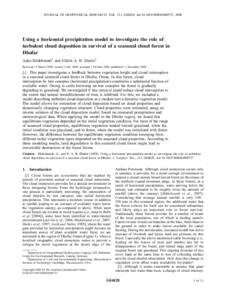Document
Using a horizontal precipitation model to investigate the role of turbulent cloud deposition in survival ofa seasonal cloud forest in Dhofar.
Identifier
DOI: 10.1029/2008JG000727
Contributors
Eltahir, Elfatih A. B., Author
Publisher
Blackwell Publishing Ltd.
Gregorian
2008-12
Language
English
English abstract
This paper investigates a feedback between vegetation height and cloud interception in a seasonal semiarid cloud forest in Dhofar, Oman. In this forest, cloud interception by tree canopies (horizontal precipitation) constitutes a substantial fraction of available water. Owing to cattle browsing on tree canopies the forest is gradually degrading to grassland. We investigated if tree removal could reduce cloud interception to the extent that natural reestablishment of trees is inhibited. For this, we included a model describing turbulent cloud deposition as a module into a dynamic vegetation model. The model allows for estimation of cloud deposition based on cloud properties and dynamically changing vegetation structure. Cloud properties were estimated, using an inverse solution of the cloud deposition model, based on measured precipitation and meteorological data. When applying the model to the Dhofar region, we found that equilibrium vegetation depended on the initial vegetation condition. For most of the range of assumed cloud properties, equilibrium vegetation tended toward grassland, when the initial condition was grassland, and to forest, when the model was initialized with forest. However, the difference between the equilibrium vegetation condition emerging from different initial vegetation types depended on the assumed cloud properties. According to these modeling results, land degradation in this semiarid cloud forest might lead to irreversible destruction of the forest biome.
Member of
ISSN
0148-0227
Resource URL
Category
Journal articles


